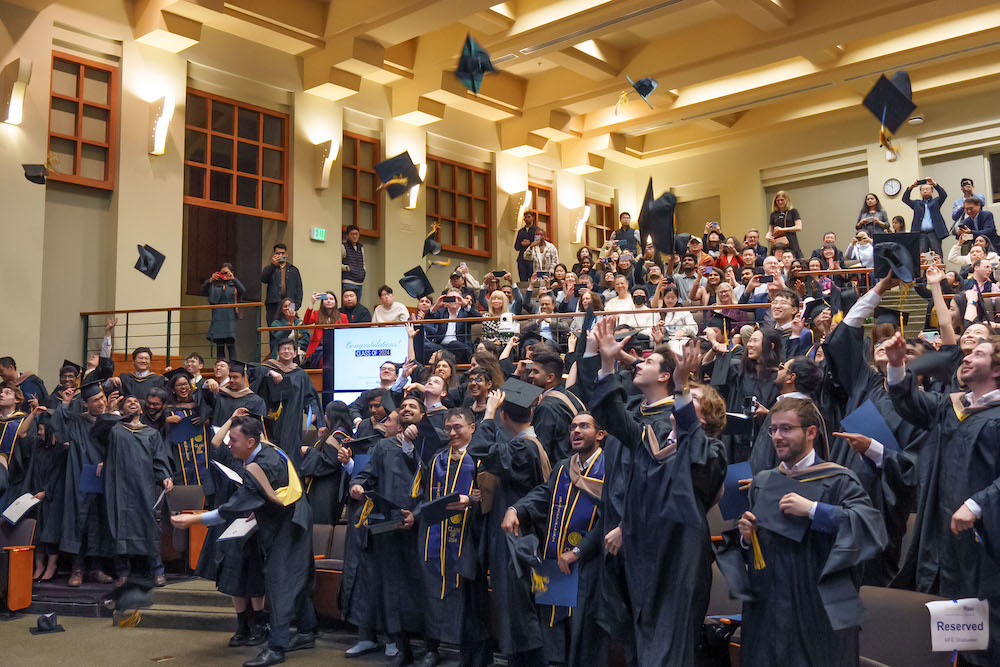
Ananth Madhavan was ready to retire after decades as a leader in the financial sector. But that all changed when he saw an opportunity he couldn’t pass up—becoming the next executive director of the Berkeley Haas Master of Financial Engineering (MFE) Program.
“I thought I was going to be traveling the world and enjoying myself, but then this job opening came up and it was such a unique opportunity,” said Madhavan, who spent more than 20 years in various roles at Barclays Global Investors (BGI) and then BlackRock, which acquired BGI in 2009. “This program is such a jewel.”
“This program is such a jewel.”
– Ananth Madhavan
In his new role, Madhavan said he has embarked on a listening tour, meeting with stakeholders ranging from students and alumni to university leadership and industry partners. His goal is to gain a 360-degree understanding of the program and identify opportunities for growth.
The curriculum is one area of focus. Madhavan aims to ensure it remains relevant in a rapidly changing financial landscape. With the rise of private equity, private credit, and AI-driven finance, the program must adapt to prepare students for these emerging opportunities.
Madhavan is also committed to maintaining the program’s exceptional placement rates—with 96% of students receiving full-time offers after graduation. He regularly consults with industry partners, including leading investment firms, to understand their needs and align the program’s offerings accordingly. “It’s essential to keep the curriculum refreshed and ensure students graduate with the skills and knowledge that employers value,” he said.

Focus on key industry areas
With a focus on market microstructure, trading, asset management, and exchange-traded funds (ETFs), Madhavan’s had a front-row seat to some of the most exciting developments in finance today. He highlights three key areas shaping the industry:
• AI and Large Language Models: Madhavan is enthusiastic about the potential of AI to transform finance. From uncovering hidden patterns in data to automating tasks like reading corporate reports in multiple languages, he believes AI is just beginning to revolutionize risk management and alpha generation.
• Private Markets: The explosive growth of private equity and private credit has created new career paths for MFE graduates. Madhavan sees these areas as critical components of the program’s future focus.
• Cryptocurrency and Emerging Technologies: While still evolving, cryptocurrencies and blockchain technologies continue to capture the interest of students and industry leaders. Madhavan believes the long-term applications of these technologies will become clearer in the coming years.
Deep academic roots
Although he retired from private industry, Madhavan’s academic roots run deep. He is the author of an Oxford University Press book on ETFs and index investing, and has published more than 60 articles in leading academic and practitioner journals. After earning a PhD in economics from Cornell University, Madhaven taught at the Wharton School and later at USC, where he achieved tenure and became a chaired professor.
However, his fascination with applying theoretical finance to real-world problems led him to consult for a New York broker-dealer, developing trading algorithms. Madhavan loved the work so much he asked for a leave of absence from USC to join the firm full-time. “It was fascinating work,” which he said allowed him to bridge theory with practice
A pivotal moment came when Barclays Global Investors (BGI) offered him a role in San Francisco, tasked with managing the firm’s market impact. At the time, BGI managed $900 billion—a figure that astounded him.
In 2016, Madhavan reconnected with his academic roots, accepting a part-time lectureship at Haas, where he taught an elective on financial innovation through the lens of data science.
“The students were very smart, very engaged, and fun to be around,” he said. “It was also fun for me to combine my theoretical knowledge from academia with the practical insights I’d gained over the years.”
Those fond memories came into play when the chance to lead the MFE program arose.
“The best part of teaching at Haas is the quality of the students and the quality of the faculty,” Madhavan said. “You’re surrounded by really great people and there are always interesting ideas bubbling up.”
The next MFE chapter
As he leads the MFE program into its next chapter, Madhavan remains committed to upholding its reputation for excellence while preparing students for the challenges and opportunities of tomorrow’s financial world.

For Madhavan, the MFE program is more than a stepping stone for students—it’s a dynamic platform for shaping the future of finance. By leveraging his extensive experience and the strengths of the Haas community, he aims to ensure the program continues to thrive as a leader in financial education.
“The marketplace today is very different. We used to set our sights on the sell side—the broker dealers, like Goldman. Now, it’s a much broader mix of jobs,” he said. “So, we need to pivot accordingly.”
Posted in: